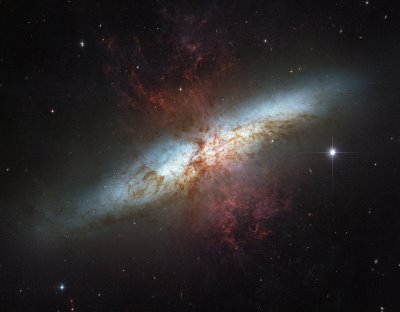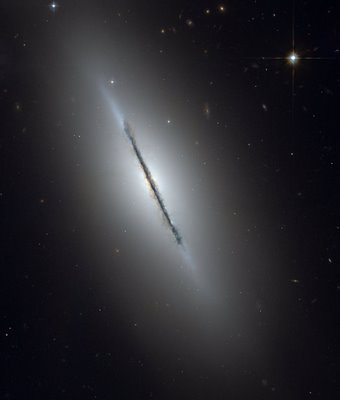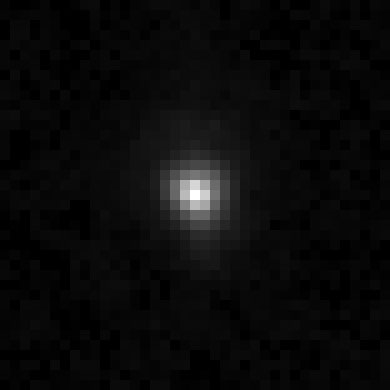Fair enough. In the spirit of the assignment, I'll stick to pictures from the 2006 Hubble press releases. Hubble has a strong University of Arizona connection, so I have a certain "brand loyalty" to the space telescope that could.
The Hourglass - Hula Hoop Galaxy
 This is the Messier 82 (M82) Galaxy. I think it deserves a better name. The press release from April, which was to "celebrate the Hubble Space Telescope's 16 years of success," says,
This is the Messier 82 (M82) Galaxy. I think it deserves a better name. The press release from April, which was to "celebrate the Hubble Space Telescope's 16 years of success," says,"This mosaic image is the sharpest wide-angle view ever obtained of M82. The galaxy is remarkable for its bright blue disk, webs of shredded clouds, and fiery-looking plumes of glowing hydrogen blasting out of its central regions. The observation was made in March 2006."
I like that it's sort of an hour glass shape with a cloudy hula hoop shape around its "waist."
The Broken Shoelace Galaxy?

Is this a broken piece of a glow-in-the-dark shoelace? No indeed. This is a big, flat galaxy, hiding from the Hubble camera by facing sideways (end-on). I saw a stealth bomber do that once over White Sands.
Quoting the press release again:
NGC 5866 is a disk galaxy of type "S0" (pronounced s-zero). Viewed face on, it would look like a smooth, flat disk with little spiral structure. It remains in the spiral category because of the flatness of the main disk of stars as opposed to the more spherically rotund (or ellipsoidal) class of galaxies called "ellipticals." Such S0 galaxies, with disks like spirals and large bulges like ellipticals, are called 'lenticular' galaxies. NGC 5866 lies in the Northern constellation Draco, at a distance of 44 million light-years. It has a diameter of roughly 60,000 light-years only two-thirds the diameter of the Milky Way, although its mass is similar to our galaxy. This Hubble image of NGC 5866 is a combination of blue, green and red observations taken with the Advanced Camera for Surveys in February 2006.
Some Tenth Planet or Other
 There were other press releases I found potentially more interesting, but they tended to come with artists' renderings instead of photos. These were mostly about Pluto and its neighbors, both moons and bite-sized planets. For example, did you know that the Earth has a tenth planet, which Hubble has measured out to be slightly larger than Pluto? It's true! Did you know also that the tenth planet is called Xena by its discoverer? I swear, I'm not making that up! In case you were wondering, the planet Xena does have a companion called Gabrielle. Here's the picture of it that isn't an artist's rendering. Sure, it's disappointingly low-res, but the remarkable thing is that the photo exists at all. It shows almost nothing, but I think it's my favorite 2006 Hubble photo anyway. By the way, the boring name for Xena is Kuiper Belt Object 2003 UB313.
There were other press releases I found potentially more interesting, but they tended to come with artists' renderings instead of photos. These were mostly about Pluto and its neighbors, both moons and bite-sized planets. For example, did you know that the Earth has a tenth planet, which Hubble has measured out to be slightly larger than Pluto? It's true! Did you know also that the tenth planet is called Xena by its discoverer? I swear, I'm not making that up! In case you were wondering, the planet Xena does have a companion called Gabrielle. Here's the picture of it that isn't an artist's rendering. Sure, it's disappointingly low-res, but the remarkable thing is that the photo exists at all. It shows almost nothing, but I think it's my favorite 2006 Hubble photo anyway. By the way, the boring name for Xena is Kuiper Belt Object 2003 UB313.Wikipedia lists other candidates and proposed names for the distinction of being the tenth planet in our solar system. And, final fun fact on this obscure planetoid (My Very Educated Mother Just Sat Upon Nine Pillows Xactly): did you know that The Tenth Planet is where the Doctor first encountered the Cybermen? I'm pretty sure it was a different tenth planet, though. It was called Mondas.
Karen
2 comments:
Great choices... I didn't think about narrowing my selection to 2006. The Hourglass and the Broken Shoelace Galaxies are pretty cool. Thanks for bringing them to our attention. bea
I really love the Broken Shoelace Galaxy. That one is just beautiful!
Definitely some great pics... er, picks here.
Post a Comment